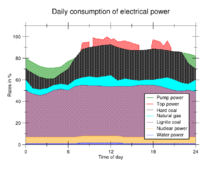Peak demand
Peak demand on an
Some utilities will charge customers based on their individual peak demand. The highest demand during each month or even a single 15 to 30 minute period of highest use in the previous year may be used to calculate charges.
Economic growth of the state is inversely associated with peak load.[5]
Demand Tariff
Electricity network is built to deal with the highest possible peak demand otherwise blackout may happen. In Australia, demand tariff has three components: peak demand charge, energy charge and daily connection charge. For example, for large customers (commercial, industrial or mixed of commercial/residential), the peak demand charge is based on the highest 30 minutes electricity consumption in a month; the energy charge is based on a month electricity consumption. This type of demand tariff is gradually introduced to residential households and will be rolled out by 2020 in Queensland Australia. How to manage electricity bills under demand tariff can be challenging. The key solutions involve improving building efficiency and managing the operational settings of large power appliances.[6]
Time of Peak Demand
Peak Demand depends on the demography, the economy, the weather, the climate, the season, the day of the week and other factors. In industrialised regions of China or Germany, the peak demands mostly occur in day time. However, in more service based economy such as Australia, the daily peak demands often occur in the late afternoon to early evening time (e.g. 4pm to 8pm). Residential and commercial electricity demand contributes a lot to this type of network peak demand.[7]
Off-peak
Peak demand is considered to be the opposite to off-peak hours when power demand is usually low. There are off-peak
Response

Peak demand may exceed the maximum supply levels that the
Power stations
The chances that a wind farm will be unable to meet peak demand are greater than for a fossil-fueled power station, due to the ability to store liquid fuels for use during peak demand.[8]
Solar power's peak output often naturally coincides with daytime peaks of usage due to air conditioning.
See also
- Congestion pricing
- Diversity factor
- Merit order
- Electricity market
- Energy storage
- List of energy storage projects
- Peak oil
- Price elasticity of demand
- V2G
References
- ^ Torriti, Jacopo. "Peak energy demand and Demand Side Response".
- ISBN 1438409990. Retrieved 25 June 2013.
- ISBN 978-1420063394. Retrieved 25 June 2013.
- ISSN 0960-1481.
- .
- ^ L. Liu, W. Miller, and G. Ledwich. (2017) Solutions for reducing electricity costs for communal facilities. Australian Ageing Agenda. 39-40. Available: https://www.australianageingagenda.com.au/2017/10/27/solutions-reducing-facility-electricity-costs/ Archived 2019-05-20 at the Wayback Machine
- ^ L. Liu, M. Shafiei, G. Ledwich, W. Miller, and G. Nourbakhsh, "Correlation Study of Residential Community Demand with High PV Penetration," Australasian Universities Power Engineering Conference, p. 6
- ISBN 978-0104013779. Retrieved 25 June 2013.

